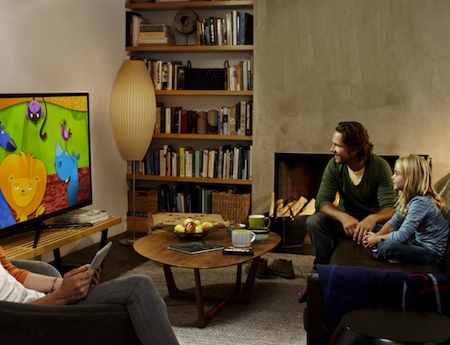Guest Blog: The Near-Death Experience of Linear Television

In 2008, Broadcasting & Cable published an article I wrote defending linear television against the onslaught of doomsday soothsayers predicting its complete demise within five years. It was a chant I heard not only from the Bay Area IPTV generation, but even within the more conservative ranks of broadcast operations and engineering executives. Each big reveal, like this week’s from Nickelodeon about an over-the-top offering, brings back more echoes.
When I argued the case for linear TV, I was peppered with skepticism from friends and critics alike, who thought my wild opinions recalled a time when those slow to adapt rebelled against the heretical notion that Earth actually revolved around the sun. Six years later, it turns out it not only is very much alive, but poised for more growth.
Dis-cord-ant logic
Cord cutting, despite all of the dire predictions by producers, programmers and CTOs alike, did not actually commence in earnest until 2013, when for the first time there was a net loss of cable subscribers. Defections could proliferate with new offerings like Verizon’s new FiOS Internet TV package and new streaming services from Dish/Sling TV, CBS and soon HBO. (Nickelodeon’s expected OTT announcement Wednesday will also be closely watched.) Some consumers might even re-discover free terrestrial broadcast via HD antennae.
None of this is a repudiation of linear TV, however, but rather a response to programming bundles imposed by the operators and networks alike. Consumers are tired of paying up to $200 a month for five times more content than they actually consume.
And consider this: About half of the cord cutters, it turned out, simply migrated to satellite providers. When my son left for college, he signed up for Hulu Plus but never actually had a cord of his own to cut. When he graduated, however, and had his own apartment, the first thing he did was sign up for DirecTV with its NFL package, as did many of his friends. While he did keep Hulu, there was no zero-sum gain, as many predicted.
Streaming Brings Tradeoffs
Many of us love the freedom of choice that on-demand services like Netflix provide. And who can beat the cost? But there are clearly trade-offs. Those of us who accustomed to the ease at which one can flip through a linear channel guide and instantly watch a show in almost pristine quality are a bit taken aback when watching what many call the “spinning wheel of death” while waiting for a program to buffer (even with a high-speed broadband connection).
Net neutrality issues aside, broadcasters and cable operators offer dedicated bandwidth direct to your home. SVOD service providers rely on a myriad of ISPs and CDN providers to ultimately make that connection, with limited control over the outcome. Some of the quality issues are most certainly related to business decisions in terms of the ROI and costs associated with low latency and high picture quality we have been accustomed to viewing in the linear world.
Quality of service will no doubt improve, as no one would dispute some of the benefits of IP content delivery. But watch for broadcasters to compete as they develop their next broadcast delivery standard using IP (ATSC 3). With dedicated bandwidth, excellent QoS, and the ability to easily reach the mobile consumer with both video and data, broadcast is poised for further growth, as evidenced by the recent rash of station acquisitions by “super group” owners like Sinclair and Gannett.
Linear is still popular today because of its ease of finding what’s available right now rather that wading through a virtually unlimited choice of on-demand options. While we all agree choice is good, unlimited choice can be at times be paradoxically paralyzing. (Just think of being in a restaurant with an unlimited choice of options on the menu).
MSOs, in expanding their number of on-demand offerings as an adjunct to their linear services have tried to give consumers the best of both worlds, making it an easier experience for their customers to navigate and chose. What is clearly missing and needed is a universal search app that will enable navigation across SVOD providers and bridge the gap with linear services.
The Revolution Will Be Slow
In short, there is a slow revolution going on, not the chaotic disruption many predicted. Audiences and revenues will continue to migrate to OTT on-demand services over time, based on more attractive pricing, although the prices of those new services will ultimately increase as they use original content to attract new viewers. Or they will remain compelled to pay for linear offerings because of the raft of sports, news, awards, reality competition and other live fare increasingly dominating the dial. Some consumers will cut the cord completely. Others may simply reduce their cable packages and use OTT to supplement their linear content. Let’s not forget that the MSOs and telcos are also the country’s largest ISPs, and generate higher margins on their broadband offerings than their television services. They win either way.
In either event, linear, in my opinion, is here to stay, and will effectively compete as well as complement SVOD offerings. New upfront deals offered by streaming services such as Amazon for network content are mitigating some of the financial risks by creating a new guaranteed revenue stream, thereby lessening the impact of Nielsen ratings. SVOD services, in turn, rely heavily on the television networks for their promotional muscle, which gives the show new life after first airing. Consumers can catch-up or binge as they like, fueling the popularity of the show in real time. The end result will be digital détente—peaceful “co-op-etition,” and the ultimate in choice for the consumer.
Ron Quartararo is director, business development, communications, media and entertainment for Hitachi Data Systems.
Broadcasting & Cable Newsletter
The smarter way to stay on top of broadcasting and cable industry. Sign up below
